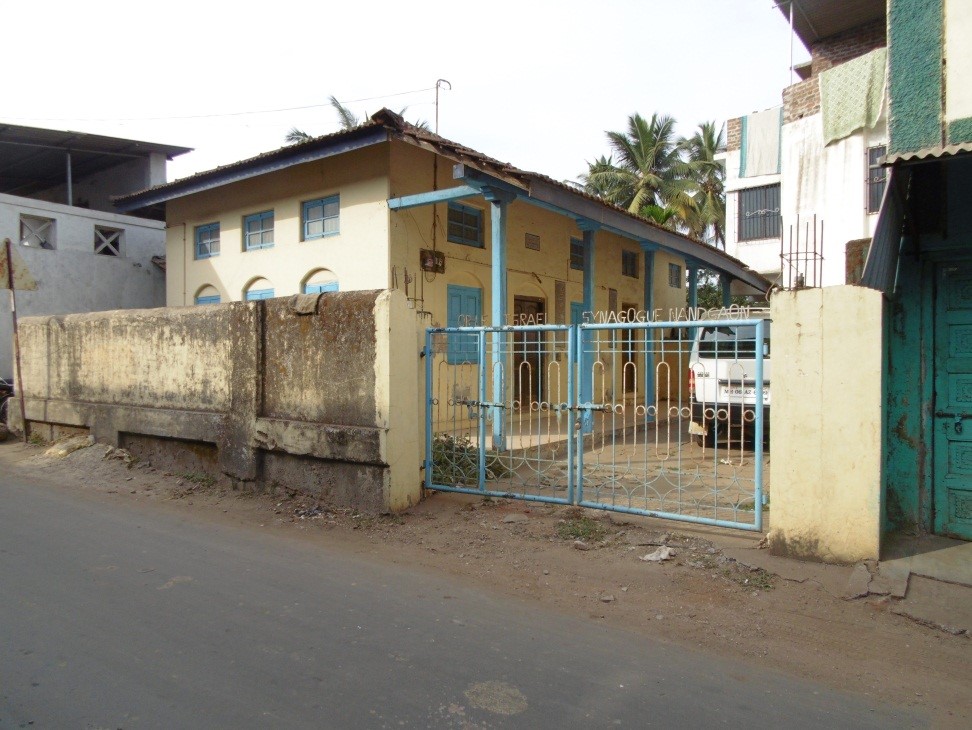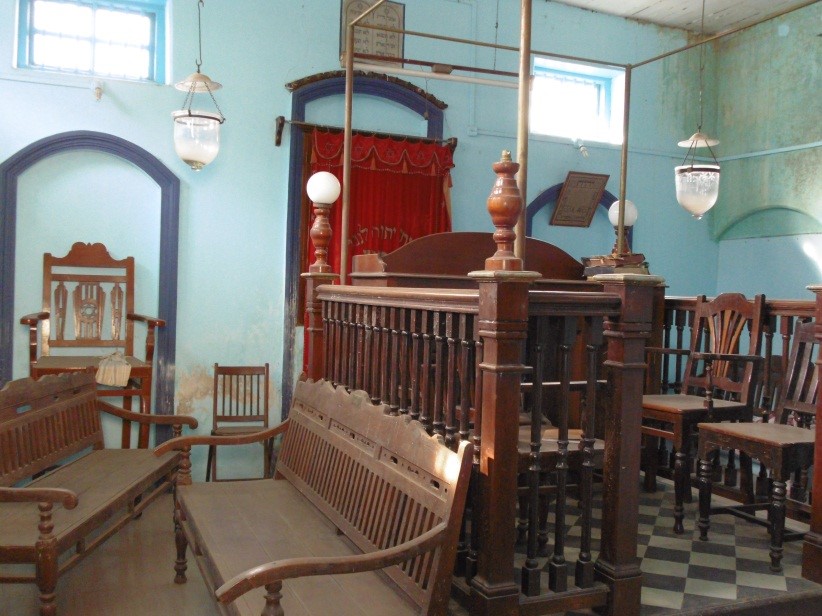ORLE ISRAEL SYNAGOGUE (1896)
Zurul Peth (Lane)
Tehsil (municipality) of Nandgoan Murad
Raigad District, Konkan Region
Maharashtra, INDIA
This synagogue is now closed and locked. Access to it needs to be arranged in advance by the Bene Israel community in Mumbai, otherwise it will be unlikely that visitors will be able to see the inside of the building since the key is not always available locally. To reach this former synagogue and the nine others throughout the sprawling and picturesque Konkan Region, it is best to hire a car and driver from Mumbai for two full days. There is a convenient ferry that takes passengers from Mumbai’s Gate of India to Alibag in the Konkan Region. Here travelers would have to arrange for private transportation to this and other regional synagogues, which will be challenging since finding someone near the ferry jetty who knows where they are all located is difficult. The alternative is to begin in Mumbai via informed car and driver, and travel all by roads. This is the longer option but will insure that all the synagogues can be reached. For the overnight stay, the comfortable Radisson Hotel on Alibag-Pen Road, Gondhalpada, Varasoli, Alibag, Raigad is suggested.
Orle Israel (Hebrew for Light of Israel) Synagogue, located in the tehsil (municipality) of Nandgoan Murad, represents one of thirteen Bene Israel congregations that were organized in the Raigad District of the Konkan Region of coastal Maharashtra during the mid-to-late nineteenth century. Of those, ten buildings remain standing today. Initially these Jewish congregations held prayer services in private homes or temporary facilities, yet in time proper synagogues were erected. Orle Israel was organized as a congregation in the late 1880s, and within a few years a proper synagogue to serve as a base for the religious and communal needs of its membership became necessary. In 1895, construction of a synagogue began, and it was consecrated the following year. Much of the cost was paid for by a community member, Havaldar Moses Malyankar. In 1945, the structure was replaced by a new, larger one.
The synagogue is positioned on Zurul Peth(Lane) just down the street from a large Hindu temple and across the street from what were once Jewish homes. The road is line with modern and pre-modern buildings, including shops, houses, and small businesses. Nearby, closer to the main street, is a mosque. Today the town has a large Muslim population.
Orle Israel’s property is fronted by a chunam (polished lime) over masonry wall running along the village road. This solid wall is interrupted by a swinging wide painted iron gate that in recent decades replaced an earlier one. Atop the gate, are the words “ORLE ISRAEL SYNAGOGUE NANDGAON.”
The synagogue is a small, low-slung structure constructed of simple structural brick veneered in painted chunam. These thick walls, today painted pale yellow and deteriorated in some sections, support a hip gable roof framed in wood that is covered in clay roof tiles. Orle Israel’s roof features deep overhangs in response to the region’s annual monsoons and hot climate. The exterior walls of the synagogue are mostly plain and without trim and ornamentation, with only a water table. The wooden fascia is flat and painted a medium blue. Wooden shutters and clerestories are painted the same blue, and the tops of the window openings are arched and filled since the window units are rectangular.
A two-story covered porch, contained by a wooden balustrade, runs along the short (east) end of Orle Israel. Doors at the porch open into the sanctuary. Adjacent to porch is a stair up to the women’s gallery. Orle Israe’s other short elevation (at the west side of the building) contains an apse for the heckal, or ark.
The rectangular sanctuary follows the spatial planning of other Bene Israel synagogues with its centrally-positioned, raised tebah (bimah, or platfrom containing a table where the Torah is read) and to the far wall the heckal (ark). The tebah is constructed out of wood that has been painted. Its design includes raised panels at its base, turned newel posts and balusters, and a shaped handrail. Placed in the center of the western elevation that is closest to Jerusalem as is traditional, the heckal is a wooden cabinet that is draped in the traditional curtain called the parochet. The heckal, as in many synagogues, is raised off the floor by a few steps.
Orle Israel’s sanctuary is finished with stone floor pavers, painted chunam walls, framed Hebrew prayer verses displayed around the room, painted dark blue wood casement windows with louvered shutters, and clerestories units. Hanging from the flat ceiling with applied battens are ceiling fans, glass lanterns, and lighting fixtures. These objects are common to other Bene Israel synagogues in this region and elsewhere in India. Other architectural and liturgical design features of the sanctuary include the freestanding wooden benches and chairs along the perimeter of the room and the pair of draped chairs adjacent to the heckal. One is for the Elijah, and the other used for the circumcision ceremony.
Oral tradition tells us that the Bene Israel were traders from the Middle East who conducted business in India as far back as ancient times. Eventually they settled – perhaps more than two millennia ago – in small towns and villages in the Raigad District within the Konkan Region of coastal Maharashtra. They lived there for centuries as a disaporic Jewish enclave, following various Jewish customs and practices while coexisting with larger Indian communities. Centuries later, beginning in late 1700s but especially by the mid-1800s, many of the Bene Israel relocated to Mumbai as well as Ahmedabad, Pune, and Karachi when these cities were expanding and offering job and lifestyle opportunities. Some Bene Israel Jews chose to stay in the Raigad District within the Raigad District as others moved away. For those that remained here, this synagogue and others continued to remain active religious and communal centers for many more decades.
Beginning in the mid-twentieth century, as a result of political and social changes in India, the Bene Israel Jews began to emigrate. At that point, the Bene Israel population dropped from an estimated twenty thousand to a few thousand, and today the number of Jews currently living in the Raigad District is quite small. Of the thirteen synagogue buildings built in the towns and villages in this region from the mid-nineteenth to early twentieth centuries, eleven survive today. Of those, some remain active houses of prayers, others endure marginally, and the rest have been converted to other functions. These vernacular structures, appropriately scaled and decorated for their function, served their congregations well for many years. They are a testament to the region diversity and to India’s tradition of tolerance.

Exterior

Interior








